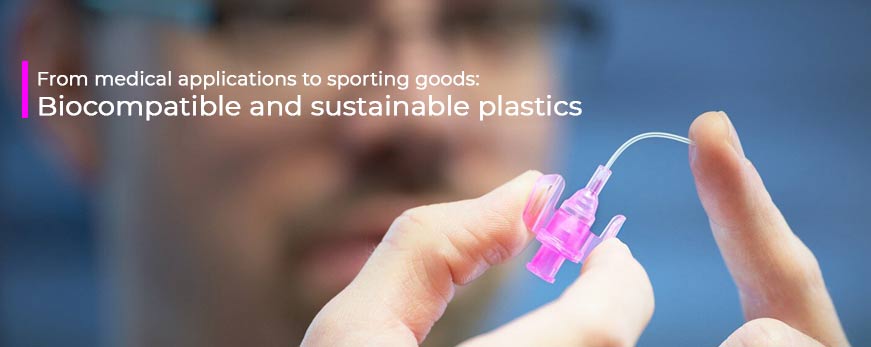Biocompatible and sustainable plastics
Numerous plastic products are made of polyurethanes. Fraunhofer researchers have developed a manufacturing method for polyurethanes that avoids use of toxic isocyanates while making use of carbon dioxide as a starting material. Polyurethanes of a reproducible standard are being developed in collaboration with partners from industry. The research results can be seen from November 15 to 18 at MEDICA 2021 in Düsseldorf (hall 3, stand E74).
Polyurethane is a multipurpose material. This type of plastic is used as foam for mattresses, as packaging material, as elastic material for sporting goods and as sealing material, paint, adhesive, construction foam and much more.
The material is even used in medical applications—for example in the form of tubes for intravenous catheters. Researchers from the Fraunhofer Institutes for Applied Polymer Research IAP, for Chemical Technology ICT, for Manufacturing Technology and Advanced Materials IFAM and for Environmental, Safety and Energy Technology UMSICHT are now exploring new ways to produce this type of plastic sustainably and without the use of toxic materials.
Polymer Products of Zarif-mosavar Industrial Group: Geomembrane sheet and Masterbatch
Non-toxic: no isocyanates
Generally, a modular system consisting of three building blocks is used to produce polyurethanes: isocyanates, chain extenders and polyols. The properties of the product can be controlled very precisely by means of the recipe and process parameters.
Due to the isocyanates being highly reactive, the products can be created in a matter of minutes.. But there is a drawback. Isocyanates are toxic and sensitizing substances that can cause allergic reactions and asthmatic symptoms.
The European Chemicals Agency EChA has therefore decided to impose a restriction: From 2023, only specially trained personnel will be allowed to work with formulations containing more than 0.1 percent of isocyanate.
“With our new synthesis, we avoid toxic isocyanates, thereby enabling safer production processes. The polyurethane we produce in this way can also be certified as biocompatible,” explains Dr. Christoph Herfurth, a scientist at the Fraunhofer Institute for Applied polymer Research IAP and coordinator of the project.
To achieve this, the researchers replaced the isocyanates with dicarbamate. They aim to make the process efficient and industrially feasible. The research teams are now also working on more sustainable agents for foaming the polyurethanes.
Products of Zarif-Mosavar Industrial Group
Sustainable: the use of carbon dioxide
“Instead of using fossil fuels, e.g. crude oil or natural gas, as a carbon source for the polyurethanes, we use carbon dioxide and polyurethane recyclates,” explains Herfurth. “This way, we can recycle the carbon and ensure that a lower amount of damaging CO2 is released into the atmosphere.”
This process is already up and running; pressure and elevated temperatures are required for this. The researchers at the Fraunhofer Institutes are currently working on ways to optimize the processes.
9 Applications of Geomembranes in various industries
Innovative: various demonstrators
At first, the project team will focus on developing the building blocks for polyurethane production. The researchers will also investigate the relationships between the process parameters and structural properties: How do you achieve the properties that make conventional polyurethanes so versatile?
Three different demonstrators will illustrate the various applications of this new form of polyurethane: The first will be sustainable tubes for medical applications. Here, only comparatively small quantities of polyurethanes are needed.
This makes it easier to launch a new product. In a second application, adhesives are being developed at Fraunhofer IFAM optimized for the new polyurethanes to allow cannulas to be bonded to medical tubing, for example, for catheters. The third demonstrator on the agenda is foam, and with it processing technologies for mass-produced products.
source: phys.org

